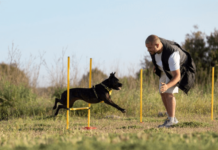Last Updated on April 25, 2024 by Dogs Vets
Head injuries from dog attacks present a serious health concern that requires immediate and effective medical intervention. These injuries can range from superficial lacerations to more severe trauma, such as skull fractures or traumatic brain injury.
Proper evaluation and prompt treatment are critical to prevent long-term complications and ensure the best recovery for the victim.
It is also essential for victims to understand their legal rights following such incidents. Consulting a Pittsburgh dog bite lawyer can help victims manage the legal aspects of their case, including claims for medical expenses and compensation for pain and suffering.
This legal support is crucial in dealing with the consequences of an attack, ensuring that victims receive the necessary resources to aid their recovery.
Managing head injuries involves a comprehensive approach, from the initial assessment to advanced medical interventions and ongoing rehabilitation strategies.
This article explores the key aspects of managing such injuries, providing valuable information for victims and caregivers.
Immediate Response and First Aid
Immediate and effective first aid is critical in managing head injuries resulting from dog attacks. Here are the key steps to take in response to such emergencies:
- Quick Assessment: Swiftly assess the victim for consciousness and monitor their breathing. Check for visible injuries, especially bleeding, and apply gentle pressure to the wounds to control blood loss without disturbing any debris embedded in the wound.
- Calm and Immobilization: Keep the victim calm and still to prevent further injury. Avoid moving the victim unnecessarily, especially if there is a suspected fracture or deep laceration, as this can worsen the injury.
- Immobilize the Affected Area: If a head or neck injury is suspected, it’s vital to immobilize these areas to prevent additional damage. Use whatever materials are available to keep the head and neck as stationary as possible until emergency responders arrive.
- Call for Help: Immediately call emergency services to get professional medical help to the scene as soon as possible. Provide clear information about the location and nature of the injuries to ensure a quick and appropriate response.
Medical Evaluation and Imaging
Upon arrival at a medical facility, healthcare professionals conduct a thorough evaluation.
This includes a physical examination and potentially a series of diagnostic tests such as X-rays, CT scans, or MRIs to assess any fractures, brain injuries, or other internal damages. These imaging tests are critical for determining the extent of the injuries and planning the appropriate treatment.

Doctors may also perform neurological assessments to check for signs of brain trauma, including loss of consciousness, confusion, difficulties with coordination, or memory problems.
These assessments help to establish a baseline for monitoring recovery and determining the severity of the brain injury.
Treatment Options for Head Injuries
Treatment for head injuries resulting from dog attacks varies depending on the severity and nature of the injury. For minor injuries, medical treatment may involve cleaning and dressing wounds and sometimes suturing lacerations to promote healing.
Additionally, tetanus shots or antibiotics may be prescribed to prevent infections, which are common risks associated with animal bites.
In cases of more severe injuries, such as fractures or traumatic brain injuries, surgical intervention may be necessary. These procedures aim to repair damaged structures or alleviate pressure on the brain to prevent further harm.
Surgical intervention is critical to stabilizing the patient’s condition and setting the stage for recovery.
Following surgery, a comprehensive and multidisciplinary rehabilitation program is often required. This program may include physical therapy to regain strength and mobility, occupational therapy to assist with everyday activities, and counseling to address cognitive and emotional challenges arising from the injury.
This holistic approach is vital to help patients achieve the best possible recovery and adapt to life post-injury.
Legal Considerations and Compensation
Victims of dog attacks may face significant medical expenses and potential long-term disability. In such cases, understanding legal rights and the possibility of compensation is crucial. A lawyer specializing in dog bite cases can help victims navigate the legal process to claim damages for medical costs, lost wages, and pain and suffering.
These legal experts will gather evidence, document injuries, and build a case to hold the dog owner accountable under local laws. Effective legal representation ensures that victims are fairly compensated, allowing them to focus on recovery without the added stress of financial burdens.
Rehabilitation and Long-Term Care
Recovery from serious head injuries can be a lengthy process, requiring ongoing rehabilitation. This may involve working with a team of health professionals to regain physical abilities and manage any psychological effects, such as PTSD, which are common in traumatic events like dog attacks.
Long-term care plans may include regular therapy sessions, support groups, and possibly modifications to living arrangements to accommodate any lasting disabilities. The goal is to maximize independence and improve the quality of life, adapting the recovery process to each individual’s needs.
Educating the Public on Dog Safety
Prevention is a key component in reducing the incidence of dog attacks. Public education on how to safely interact with dogs, recognizing warning signs of aggression, and understanding the importance of proper dog training and socialization can all contribute to fewer injuries.
Communities and pet organizations can work together to offer workshops and training sessions to promote safer environments.
Educational programs should also inform people about the legal responsibilities of owning a dog, including leash laws and the need for regular veterinary care to manage a pet’s health and behavior. By increasing awareness, individuals can take proactive steps to prevent situations that might lead to aggressive behaviors from dogs.
Comprehensive Care and Community Support
Managing head injuries from dog attacks necessitates a comprehensive approach that spans from immediate medical care to long-term rehabilitation and legal advocacy.
Victims need timely and effective medical treatment to address the physical consequences of their injuries, as well as robust legal support to secure necessary compensation for their medical bills, lost wages, and pain and suffering.
Recovery is often a long and arduous process that can be eased with strong community and professional support. By implementing preventative measures and fostering greater public awareness about dog behavior and owner responsibilities, communities can help reduce the incidence of dog attacks.
Ensuring victims have access to the necessary resources is crucial for their recovery and for building safer environments for everyone.
Facts Check
We hope you enjoyed this article… What are your thoughts?
Please feel free to share this article!
We strive to provide the latest valuable information for pet lovers with accuracy and fairness. If you would like to add to this post or advertise with us, don’t hesitate reach us.
If you see something that doesn’t look right, contact us!

















